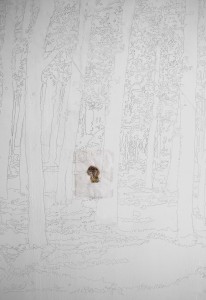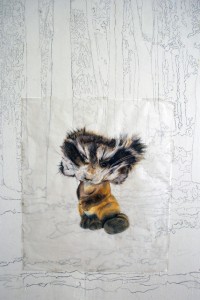Alternative Futures With Alternative Pasts
Published September 23rd, 2010 by John Megas
Alternative Futures is a challenging and wacky exhibition of recent work by Minneapolis based artists Pamela Valfer and Allen Brewer made specifically for this show. It opened September 18th at Soo Visual Arts Center in South Minneapolis.
In this exhibition, ephemera, unwanted taxidermy and just plain trash are re-purposed and manipulated to encourage us to re-imagine our take on what is real and how it relates. It considers the natural world and what happens when it is replicated and stripped down to its basics.
[caption id="attachment_348" align="aligncenter" width="223" caption=""metamorpheus". Allen Brewer"] [/caption]
[/caption]
With his work here, Allen Brewer has created a world of his own with a loose post apocalyptic narrative. It is about after the end of our civilization and only one inhabitant remains on the Earth. Allen refers to this last man on Earth simply as Jeff ( to keep him less monumental.) Jeff lives in a new Pangea which rose up from the ashes of our lost society. This new world is filled with natural beauty but is overrun by bits of left over junk from the last dozen or so decades of human existence.
These pieces are made on found wood, an old movie screen, scraps of used notebooks... some ephemera but mostly straight up garbage. Brewer draws on these items (literally), keeping an incredible respect for the original object. The rendered images are selected to pull out aesthetic qualities of the objects they are added to. These drawings are traced using old carbon paper from Allen's large collection of images from discarded magazines or advertisements . The result looks something like refuse with a dubious origin, creating a culturally confusing revisionist history. The context confuses. It is awkward and raw (and I mean this as a compliment).
[caption id="attachment_363" align="aligncenter" width="228" caption=""The End". Allen Brewer"] [/caption]
[/caption]
The pieces here acknowledge the artifice in media and art. Allen removes images from reality in stacked layers. For instance, let's say Allen draws a picture of a clown on a piece of broken PVC piping. We start with something that exists in real life, the clown. Then a photograph was taken of the clown. From there, a printed version of the photograph of the clown is run in a magazine in 1970-whatever. Then Allen Brewer comes around 30 years later with his carbon paper and traces it onto a broken piece of PVC piping. (Kind of dizzying to think about.) How does the final product relate to the real life clown. Are you looking at the real clown when you see this piece?
Pamela Valfer's work deals with some of these same themes of removing an object from reality, but she handles it in a different way. Her work here is a large installation piece.
[caption id="attachment_350" align="aligncenter" width="206" caption="Castor canadensis (American Beaver). Pamela Valfer"]
 [/caption]
[/caption]
The backdrop of this piece is a wall-sized, meticulous to the point of pushing obsessive, line drawing of a forest whose source material was a screen saver. Interspersed throughout the scene are beautifully rendered color pencil drawings of woodland animals... but not exactly. The drawings were made by Pamela from a series of sculptures she created from the cute, fuzzy animal shaped banks (popular giveaways from financial institutions in the 1970's and 80's) combined with saved before it hit the landfill taxidermy. She uses the taxidermy fur to help bring the plastic woodland animals back to their "natural" animal state by adding the actual pelts from the heads to animal that the bank represents. In other words, if it's a cute bunny bank, then the skin of a real bunny head was placed over it. With the exception of a dove suspended by balloons and a life-sized deer wearing its grotesque vintage head-skin, the images in the piece are drawings of the sculptures. (All of the actual toy- taxidermy hybrids are lurking somewhere in Pamela's studio.)

Again, all of this hijinx can bring us back to questioning what we conceive of as real and how it relates to the artifical. The life, and smell, and danger is sucked out of a raccoon when it is represented by a furry, cuddly shell with a coin slot in its back. Pamela puts some life back into these objects. She points out their disconnect from, and strange relationship to, the real. Stick the disgustingly authentic dead skin of the raccoon on that cute bank and the way we relate to it changes drastically. (Put a real raccoon in the room and we'll all run for the door.)
The same can be said about the “idealized nature screen saver” drawing mentioned earlier. The screen saver allows us to romanticize the beauty of nature even in a climate controlled office. There is obviously something innate in us as humans that responds to images of rolling hills, green trees and sparkling waters. It sells. However, edited out here are the swarms of disease filled insects, smelly feces piles, mucky swamps, and scared hungry animals. It's sterilized. Pamela's line drawn forest responds to this romanticized detachment and creates a new take on how to enjoy the “beauty of nature” while acknowledging how artificial this is.
The work here from both artists is very smart and self aware. It is also very complex and I'm probably just scratching the surface of it here.
-John Megas
///////////////////////////////////////////////////////////////
Alternative Futures
On View: Sept 18 - Oct 31st, 2010
Where: SOO Visual Arts Center
Address: 2638 Lyndale Avenue South, Minneapolis
Gallery Phone: 612.871.2263
Hours: Wednesday thru Friday, 11-7, Saturday and Sunday 10 - 6
We can't do it without you.
Help keep independent arts journalism alive in the Twin Cities.